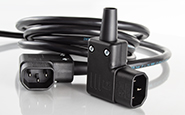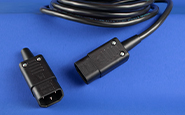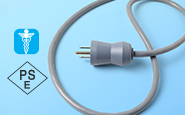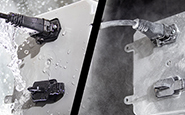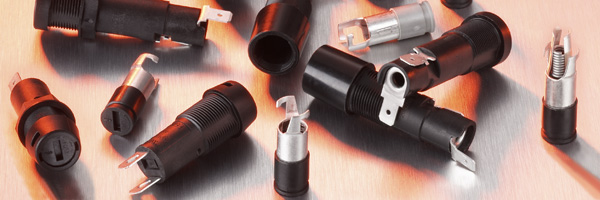How To Comply with RoHS and REACH for OEM's
OEMs (original equipment manufacturer) exporting electronic and electrical equipment into the EU (European Union) must comply with the RoHS Directive (restriction of the use of certain hazardous substances in electrical and electronic equipment 2002/95/EC) and the REACH Directive (Registration, Evaluation, Authorisation and Restriction of Chemical substances).
What is RoHS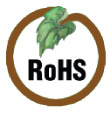
RoHS stands for the "restriction on the use of certain hazardous substances in electrical and electronic equipment". It is a European Directive aiming to control the use of certain hazardous substances in the production of new electrical and electronic equipment (EEE). It is a partner directive to the WEEE Directive (Waste in Electrical and Electronic Equipment) that controls the disposal and recycling of EEE. RoHS restricts the use of mercury, lead, hexavalent chromium, cadmium, polybrominated biphenyls and polybrominated diphenyl ethers. For more information on RoHS visit http://ec.europa.eu/environment/waste/weee/index_en.htm.
What is REACH
REACH is a new European Regulation on chemicals and their safe use. (EC 1907/2006). It deals with the Registration, Evaluation, Authorisation and Restriction of Chemical substances. The new regulation entered into force on 1 June 2007. To read more about REACH go to http://echa.europa.eu/reach_en.asp. You can also obtain a copy of the regulation and other guidance documents at http://guidance.echa.europa.eu/guidance_en.htm.
How to test and collect data for RoHS and REACH.
Testing and data collection is tedious and time- consuming. Contacting suppliers directly for information can take many phone calls and emails, and it can take weeks or in some cases months for a response.
consuming. Contacting suppliers directly for information can take many phone calls and emails, and it can take weeks or in some cases months for a response.
The process of data collection should begin with assessing and interpreting the RoHS and REACH regulations and changes made to them. A system must be in place that immediately notifies relevant personnel as soon as a crucial change is made and ideally before it is made. This is essential to keep up with REACH and RoHS, which will evolve over time. This system also comes in handy for staying on top of any number of important regulations and standards.There are many ways to collect this data. Some companies will outsource this data collection. Companies who carry out these services can be found on the internet. There also is data collection software that can be used to organize the data you received from your suppliers.
Determine who will be responsible for gathering REACH and RoHS information. It may be one person, or it may be an entire team to divide up the work and get it done. Once this is determined, those individuals should decide how they will collect RoHS and REACH information. This team should contact your suppliers to request a list of all materials and substances used in each product, the amounts of the restricted substances, and any exemptions they may be using. You can provide your own restricted substances list to your supplier requesting this information. This will help the supplier report back with the information you requested in the format you need it for your products. Some suppliers may only send you a Declaration of Conformity for the RoHS and REACH.
Once you have received your requested information, review it carefully to verify that it is for the right products you requested, that it is complete and correct and it makes sense. If you notice any discrepancies or have any questions, you should contact the supplier immediately. Test reports are ideal, especially for RoHS compliance.
Finally, create a system to record or file the information you received. Try not to make your system too complicated, keep it simple. You will want to be able to get the information out to your customers quickly when they require data for RoHS and REACH.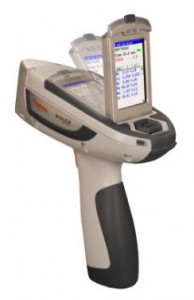
How to verify collected data for RoHS
When the initial data collection is complete, the job is not necessarily done. Now it is time to determine how your company will keep the data up-to-date. You may choose to review the supplier data and ear-mark any questionable responses for follow-up. Additional steps of further data collection, in-house screening or testing and verification, or 3rd party testing to verify results and demonstrate due diligence, may be required. The frequency and nature of these reviews should be determined by the company.
An example for verification of RoHS is the use of an Thermo Scientific Niton XRF Analyzer. The procedure is quick, easy, non-destructive, and takes as little as two minutes. As for limitations, thetest is only capable of detecting materials close to the surface. While it easily detects lead, mercury and cadmium, it cannot distinguish the specific materials PBB, PBDE (Brominated Flame Retardants) or hexavalent chromium (Cr VI) and would require further investigation if readings are too high in these areas. Some 3rd party testing labs use this type of analyzer. Be advised, test equipment for in-house testing and 3rd party testing is quite costly. However, the cost as compared to the cost of large problems down the road and potential lost customers might make these more attractive in the long run.
RoHS Compliant Fuse holders from Interpower Corporation
Interpower Corporation has expanded its fuse holder product line. There are two new RoHS compliant fuse holder series, the 8092 series, and the 8093 series. The 8092 series fuse holders are designed to accommodate both the international 5 x 20mm fuse and the North American 1/4” x 1-1/4” fuse. The 8092 series of fuse holders carries the following approvals; UL recognition at 20A, CSA at 16A and VDE at 10A. Both high and low profile types of fuse holders are being offered. The accompanying 8092 series fuse carriers are sold separately, while the 8093 series fuse carriers are included with the fuse holder. The 8093 series fuse holders are designed to accommodate the international 5 x 20mm fuse, and carries the following approvals; cURus (Canadian and US UL recognition) at 16A and VDE at 10A. All Interpower fuse holders have a rating of 250V. Additionally, these new fuse holders are rated IP40, indicating ingress protection against solid objects greater than 1mm in sizes. Both the 8092 and the 8093 series of fuse holders are panel mount with a rear hex nut. All of Interpower’s new 8092 and 8093 series of fuse holders and carriers are “touchproof” and RoHS compliant. Interpower Corporation houses over 4 million components in their warehouse so their customers don’t have to! As always Interpower offers no minimum order requirements, and specification sheets and pricing are available online at www.interpower.com. Immediate shipping is available for stock item orders received by 6:00 p.m. CST. For ordering and technical information about Interpower Corporation’s Fuse Holders and Fuse Carriers, please contact our Customer Service Department at 800/662-2290 or order online at www.interpower.com.
The Interpower Corporation Web Site Has a New Look
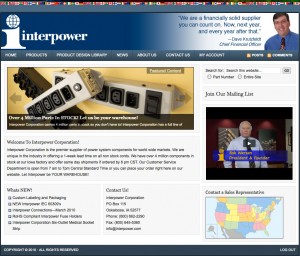 Interpower Corporation has launched a brand new web site. The goal of this re-design was to give the visitor a more personal experience, make sure all of our information was easy to access, and overall more user friendly. Along with our full product line, you will find all of our reference material under the Product Design Library tab at the top of each page. In this section of interpower.com, you will find our Designing for Export section, guide to international standards, testing agency information, webcasts, environmental information, and in-depth product line information of our entire product line. Have a look at the new web site and see for yourself. If you have any recommendations please email us at info@interpower.com.
Interpower Corporation has launched a brand new web site. The goal of this re-design was to give the visitor a more personal experience, make sure all of our information was easy to access, and overall more user friendly. Along with our full product line, you will find all of our reference material under the Product Design Library tab at the top of each page. In this section of interpower.com, you will find our Designing for Export section, guide to international standards, testing agency information, webcasts, environmental information, and in-depth product line information of our entire product line. Have a look at the new web site and see for yourself. If you have any recommendations please email us at info@interpower.com.


